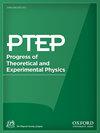Constraining the cosmological model of modified f(Q) gravity: Phantom dark energy and observational insights
IF 8.3
4区 物理与天体物理
Q1 Physics and Astronomy
引用次数: 0
Abstract
Abstract Despite the significant accomplishments of general relativity, numerous unresolved issues persist in our understanding of the cosmos. One of the most perplexing challenges is the ongoing accelerated expansion of the Universe, which continues to elude a complete explanation. Consequently, scientists have proposed various alternative theories to GR in pursuit of a deeper understanding. In our analysis, we delve into the recently proposed modified f(Q) gravity, where Q represents the non-metricity scalar responsible for gravitational effects. Specifically, we investigate a cosmological model characterized by the functional form f(Q) = Q + αQn, where α (with α ≠ 0) and n serve as free parameters. Utilizing this functional form, we construct our Hubble rate, incorporating a specific equation of state to describe the cosmic fluid. Furthermore, we leverage a dataset consisting of 31 data points from Hubble measurements and an additional 1048 data points from the Pantheon dataset. These data serve as crucial constraints for our model parameters, and we employ the Markov Chain Monte Carlo (MCMC) method to explore the parameter space and derive meaningful results. With our parameter values constrained, our analysis yields several noteworthy findings. The deceleration parameter suggests a recent accelerated phase in the cosmic expansion. In addition, the EoS parameter paints a portrait of dark energy exhibiting phantom-like characteristics. Furthermore, we delve into the application of cosmological diagnostic tools, specifically the statefinder and the Om(z) diagnostics. Both of these tools align with our previous conclusions, confirming the phantom-like behavior exhibited by our cosmological model. These results collectively contribute to our understanding of the dynamic interplay between gravity, dark energy, and the expanding cosmos.约束修正f(Q)引力的宇宙学模型:幻影暗能量和观测见解
尽管广义相对论取得了重大成就,但在我们对宇宙的理解中仍存在许多未解决的问题。最令人困惑的挑战之一是宇宙的持续加速膨胀,这仍然没有一个完整的解释。因此,科学家们提出了各种替代GR的理论,以寻求更深入的理解。在我们的分析中,我们深入研究了最近提出的修正的f(Q)引力,其中Q代表负责引力效应的非度规标量。具体来说,我们研究了一个函数形式为f(Q) = Q + α qn的宇宙学模型,其中α (α≠0)和n作为自由参数。利用这种函数形式,我们构建了哈勃速率,并结合了一个特定的状态方程来描述宇宙流体。此外,我们利用了一个数据集,该数据集由哈勃测量的31个数据点和来自万神殿数据集的额外1048个数据点组成。这些数据作为我们模型参数的关键约束,我们采用马尔可夫链蒙特卡罗(MCMC)方法来探索参数空间并得出有意义的结果。在参数值受限的情况下,我们的分析产生了几个值得注意的发现。减速参数表明最近宇宙膨胀的加速阶段。此外,EoS参数描绘了一幅暗能量表现出幽灵般的特征的肖像。此外,我们还深入研究了宇宙学诊断工具的应用,特别是状态查找器和Om(z)诊断。这两种工具都与我们之前的结论一致,证实了我们的宇宙模型所表现出的幽灵般的行为。这些结果共同有助于我们理解引力、暗能量和膨胀的宇宙之间的动态相互作用。
本文章由计算机程序翻译,如有差异,请以英文原文为准。
求助全文
约1分钟内获得全文
求助全文
来源期刊

Progress of Theoretical and Experimental Physics
PHYSICS, MULTIDISCIPLINARY-PHYSICS, PARTICLES & FIELDS
CiteScore
12.00
自引率
5.70%
发文量
148
审稿时长
17 weeks
期刊介绍:
Progress of Theoretical and Experimental Physics (PTEP) is an international journal that publishes articles on theoretical and experimental physics. PTEP is a fully open access, online-only journal published by the Physical Society of Japan.
PTEP is the successor to Progress of Theoretical Physics (PTP), which terminated in December 2012 and merged into PTEP in January 2013.
PTP was founded in 1946 by Hideki Yukawa, the first Japanese Nobel Laureate. PTEP, the successor journal to PTP, has a broader scope than that of PTP covering both theoretical and experimental physics.
PTEP mainly covers areas including particles and fields, nuclear physics, astrophysics and cosmology, beam physics and instrumentation, and general and mathematical physics.
 求助内容:
求助内容: 应助结果提醒方式:
应助结果提醒方式:


